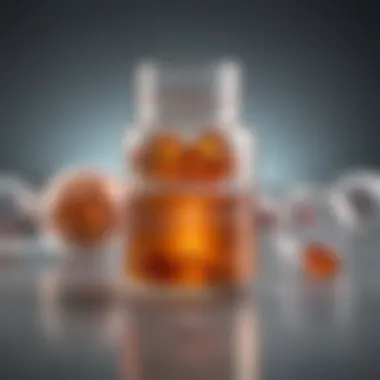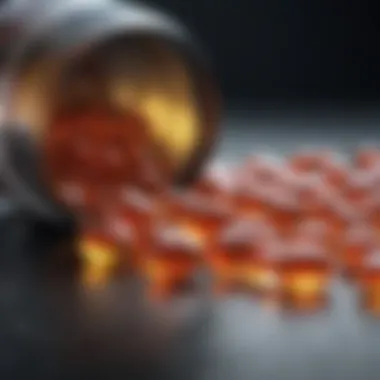Tadalafil 10mg: Efficacy Duration and Considerations


Intro
Tadalafil, a phosphodiesterase type 5 inhibitor, is commonly prescribed to manage erectile dysfunction and pulmonary arterial hypertension. The 10mg dose of tadalafil is of particular interest due to its balance of efficacy and safety. Understanding how long tadalafil remains effective in the body is crucial for both users and healthcare professionals. This section provides a foundation for exploring the pharmacokinetics, mechanisms of action, and relevant factors affecting its effectiveness.
Research Overview
Methodological Approaches
Research surrounding tadalafil, especially at the 10mg dosage, often utilizes randomized controlled trials and observational studies. These studies assess the duration of efficacy through various measurement protocols, such as patient-reported outcomes and physiological assessments. By examining the pharmacokinetics, researchers can determine how long the drug remains active in the system following administration.
In addition, methodologies such as blood sampling allow scientists to track how quickly tadalafil is metabolized by the body. This provides valuable insights into dosage timing and its impact on user experience.
Significance and Implications
The significance of understanding tadalafil's duration of efficacy cannot be understated. For individuals using the drug, knowing the optimal time for sexual activity can enhance their experience. At the same time, it aids healthcare professionals in providing informed guidance on usage. Moreover, a deeper knowledge of duration correlates with better management of side effects and drug interactions, which can be critical for certain populations.
Current Trends in Science
Innovative Techniques and Tools
Advancements in technology have enabled more precise studies of tadalafil's pharmacokinetics. Techniques such as mass spectrometry and high-performance liquid chromatography allow for exact measurement of drug concentrations in biological specimens. These innovations contribute to a clearer understanding of how tadalafil behaves within the body and can lead to the development of new guidelines for its usage.
Interdisciplinary Connections
The research on tadalafil intersects various fields, including pharmacology, urology, and cardiology. Each discipline contributes unique perspectives on the drug's effects and applications. Collaborations among these fields enable a more comprehensive understanding of how tadalafil can benefit patients with differing health conditions.
Effective use of tadalafil necessitates a collaborative approach among healthcare professionals, ensuring individualized care that addresses both efficacy and safety.
Preamble to Tadalafil
Understanding tadalafil is crucial in the context of its application in managing erectile dysfunction (ED) and pulmonary arterial hypertension (PAH). Tadalafil, a phosphodiesterase type 5 (PDE5) inhibitor, plays a significant role in enhancing blood flow to certain areas of the body by relaxing blood vessels. This is of particular importance because many men seeking treatment for ED are interested in both the efficacy and duration of the medication's effects.
Key Considerations
- Efficacy Duration: Knowing how long tadalafil remains effective helps users plan for intimacy, addressing a major concern for many.
- Convenient Usage: With its unique pharmacokinetics, tadalafil offers the flexibility of both on-demand and daily use, catering to different patient needs.
- Health Issues: Recognizing how various health conditions may affect tadalafil's performance can guide users and healthcare providers in making informed decisions.
In this article, the focus will be on elucidating the aspects that influence tadalafil’s effectiveness at a 10mg dose. This includes the biochemical interactions involved, as well as practical considerations for those looking to maximize the benefits of this medication.
Overview of Tadalafil
Tadalafil is marketed primarily under the brand name Cialis and is extensively used to treat ED and PAH. Its development was driven by the need for treatments that offer prolonged efficacy compared to its counterparts, such as sildenafil.
The drug exhibits a mechanism that enhances the natural process of erection in response to sexual stimulation. By obstructing the PDE5 enzyme, tadalafil increases levels of cyclic guanosine monophosphate (cGMP), leading to smooth muscle relaxation and vasodilation in the penis. Such mechanism has made tadalafil a preferred choice for many.
Common Uses of Tadalafil
While many associate tadalafil largely with ED treatment, its scope expands into various medical applications. The primary uses include:


- Erectile Dysfunction: Assists men in achieving and maintaining an erection suitable for sexual activity.
- Pulmonary Arterial Hypertension: Helps to lower blood pressure in the lungs by relaxing blood vessels.
- Benign Prostatic Hyperplasia: Alleviates urinary symptoms linked with prostate enlargement by relaxing muscles in the bladder.
Each of these uses demonstrates tadalafil’s versatility, appealing to a wide array of patients. Understanding these diverse applications is essential for users and healthcare professionals alike.
Pharmacodynamics of Tadalafil
Understanding the pharmacodynamics of tadalafil is crucial for comprehending its effectiveness as a treatment for erectile dysfunction and the nuances behind its use. Pharmacodynamics refers to how a drug acts on the body, primarily focusing on its biological effects and mechanisms of action. In the context of tadalafil, this encompasses how it interacts with specific enzymes and pathways to promote its beneficial effects. An in-depth analysis of this topic reveals the significance of tadalafil's mechanisms, which contribute not only to its therapeutic outcomes but also to considerations in clinical settings.
Mechanism of Action
Impact on PDE5 Enzyme
One of the key elements in tadalafil's mechanism is its impact on the phosphodiesterase type 5 (PDE5) enzyme. Tadalafil selectively inhibits this enzyme, which is primarily found in the penis. By inhibiting PDE5, tadalafil effectively increases the levels of cyclic guanosine monophosphate (cGMP). Elevated levels of cGMP promote relaxation of the smooth muscle in the corpus cavernosum and facilitate enhanced blood flow. This response is essential for achieving and maintaining an erection in the presence of sexual stimulation.
The selective nature of tadalafil for PDE5 is a beneficial characteristic. It reduces the likelihood of affecting other phosphodiesterase isoforms that could lead to unwanted side effects. Understanding this interaction provides insight into why tadalafil is preferred among different treatment options for erectile dysfunction. Its ability to prolong the action of cGMP is a unique feature, allowing for more prolonged erections compared to other medications.
Role of Nitric Oxide
Tadalafil's effectiveness is also closely linked to the role of nitric oxide (NO). In the process of achieving an erection, sexual arousal leads to the release of nitric oxide in the penis. Nitric oxide serves as a signaling molecule, stimulating the production of cGMP through the activation of guanylate cyclase. As the PDE5 enzyme is inhibited by tadalafil, this synthesis of cGMP continues, further promoting relaxation of the blood vessels.
The direct relationship between nitric oxide and tadalafil signifies why this medication is effective. It answers the cellular cues necessary for potential erection, rendering tadalafil a popular choice for many users. However, it is important to note that tadalafil does not trigger an erection without the presence of sexual stimulation, as the action of nitric oxide still remains a requisite component in this process.
Pharmacokinetics Profile
Tadalafil's pharmacokinetics profile is vital for understanding its behavior in the body, including how it is absorbed, distributed, metabolized, and eliminated. This knowledge shapes practical usage recommendations and insights into the duration of its efficacy.
Absorption and Bioavailability
The absorption of tadalafil occurs relatively quickly after oral administration. Peak plasma concentrations typically occur within two hours after ingestion. This efficiency is an important aspect because it endorses the drug's use in various contexts, such as planned sexual activity. The bioavailability of tadalafil is noted to be approximately 80%. This high level of bioavailability ensures that a significant proportion of the drug's active composition is available to exert its effects, solidifying tadalafil's reputation for effectiveness among users.
However, it is important to recognize that food intake can alter the absorption rate. High-fat meals may delay the peak concentration and overall effectiveness. This unique feature necessitates consideration of dietary habits when determining the optimal timing for administration.
Half-Life Considerations
The half-life of tadalafil is approximately 17.5 hours, making it a unique option for those seeking both on-demand and daily use. A longer half-life translates into a sustained presence of the drug in the bloodstream, which can both enhance efficacy and simplify administration schedules. Patients using tadalafil are able to achieve more spontaneity in intimate moments compared to shorter-acting alternatives.
While the long half-life is advantageous for multiple reasons, it also requires careful management. Users should be aware that the effects can persist longer than anticipated, which may not align with every user's preferences. Understanding these dynamics provides clarity in its practical applications and potential limitations.
In summary, the pharmacodynamics of tadalafil reveal how it operates within the body to deliver its therapeutic effects. By understanding the mechanisms of action involving PDE5 and nitric oxide, alongside its pharmacokinetics such as absorption and half-life, users and healthcare professionals can make informed decisions regarding its use.
Duration of Action
Understanding the duration of action for Tadalafil 10mg is crucial for users and healthcare professionals. Duration indicates not only how long the drug remains effective but also influences timing for administration in the context of sexual activity or treatment schedules. This information can significantly affect user satisfaction and overall treatment outcomes. In this section, we delve into how long Tadalafil 10mg works and the various factors that can influence this duration, including individual metabolic rates and existing health conditions.
How Long Does Tadalafil 10mg Last?
Tadalafil 10mg typically lasts between 24 to 36 hours in the body, offering a significant window of opportunity for sexual activity compared to shorter-acting alternatives. This long-lasting efficacy is one reason many users prefer Tadalafil over medications like Sildenafil, which may act for a much shorter time.
In real-world scenarios, many men report an effective duration that allows for flexibility, which can enhance spontaneity during intimate moments. However, it is essential to recognize that the experience can vary based on individual factors.
Factors Influencing Duration


The duration of Tadalafil's action is not uniform for everyone. A few key factors come into play that can modify how long the drug works in different individuals.
Individual Metabolism
Individual metabolism refers to how quickly one's body processes and eliminates substances. For Tadalafil, faster metabolism can lead to a reduced duration of action.
- Key Feature: Those with higher metabolic rates may find that Tadalafil does not last as long as it would for someone with a slower metabolism.
- Advantages: In certain situations, this can be favorable for users who prefer more control over timing.
In contrast, individuals with slower metabolism can expect prolonged effects, often extending into the next day. While this can suit some, it may not be ideal for those wanting to avoid prolonged effects outside their intended time of use.
Health Conditions
Health conditions can significantly impact how Tadalafil is processed in the body. For instance, liver and kidney function play critical roles in drug metabolism.
- Key Characteristic: Patients with hepatic or renal impairments may experience delayed clearance of Tadalafil, causing it to remain active longer.
- Disadvantages: However, this can lead to potential side effects or unwanted experiences, highlighting the importance of consulting with a healthcare provider regarding personal health status before use.
For optimal results, individuals should consider how their personal health may modify Tadalafil's effects. This understanding is crucial for effectively managing expectations and achieving the best outcomes.
Practical Implications of Use
Understanding the practical implications of using tadalafil, especially at the 10mg dosage, is essential for both users and healthcare professionals. This section aims to shed light on several considerations that can enhance the effectiveness of treatment and ensure optimal outcomes. Administering tadalafil properly can lead to improved efficacy and a better overall experience for users.
Timing of Administration
Before Sexual Activity
Taking tadalafil before sexual activity is a common practice. Users typically take the drug 30 minutes to an hour prior to intimacy. This timing allows the medication to reach effective levels in the bloodstream. The key characteristic of taking tadalafil in this manner is its quick onset of action. Since many individuals seek immediate results, this option is very popular.
Advantages of this approach include flexibility and spontaneity. Users do not need to plan for dosing every day. However, it is important to note that this method can lead to variability in effectiveness. Factors such as meal timing and individual metabolic rates can influence how quickly the drug takes effect, thus affecting user experience.
Taking tadalafil shortly before sexual activity allows for a balance between spontaneity and efficacy, but one must consider individual responses to the medication.
Daily Use Considerations
Daily use of tadalafil offers another option for users. This method is distinct because it allows for a more consistent therapeutic effect. It is often suggested for men with frequent sexual activity or those who prefer not to time their dosing around anticipated encounters. By maintaining steady drug levels in the body, users can enhance their confidence and reduce anxiety about performance.
A key characteristic of daily use is its ability to provide a continuous supply of the medication. The unique feature of this method is that users may experience benefits even outside of sexual activity, as improvements in erectile function can become more pronounced over time.
However, it is essential to consider the disadvantages as well. Daily dosing may lead to potential side effects occurring more frequently. Additionally, some may find it inconvenient to take a daily medication.
Dosage Adjustments
Dosage adjustments may be necessary depending on the individual's response to tadalafil. Various factors like age, weight, and underlying health conditions can affect how the body processes the medication. Therefore, consulting a healthcare provider to evaluate the suitability of the prescribed 10mg dose is crucial. It ensures that users can achieve the desired efficacy while minimizing risks associated with side effects.
In summary, understanding the practical implications of tadalafil use can greatly enhance its effectiveness and user satisfaction. Timing of administration and thoughtful consideration of daily or situational use play vital roles in optimizing results.
Potential Side Effects
Understanding the potential side effects of Tadalafil 10mg is essential for both users and healthcare professionals. The use of any medication comes with a responsibility to be aware of adverse reactions that may arise. Knowing these can help in making informed decisions. It can also assist in recognizing symptoms that may require medical attention. Evaluating side effects contributes to better management of expectations regarding the treatment.
Common Side Effects
Common side effects of Tadalafil may include:


- Headaches: Often reported, headaches may result from the medication's actions on blood vessels.
- Flushing: A warm sensation in the face, neck, or chest can occur.
- Indigestion: Users may experience discomfort in the stomach area, affecting eating habits.
- Nasal Congestion: Many individuals note a stuffy nose as a frequent side effect.
- Back Pain and Muscle Aches: These symptoms usually arise at the onset of the treatment.
Most common side effects are mild and tend to resolve on their own. However, the presence of such reactions should still be monitored. Users should consult healthcare providers if symptoms persist or worsen over time.
Severe Reactions
While uncommon, severe reactions to Tadalafil can occur and should never be ignored. These reactions include:
- Prolonged Erections: An erection lasting more than four hours can lead to serious complications. Immediate medical attention is necessary.
- Vision Changes: Sudden vision loss can indicate a severe issue. This requires urgent evaluation.
- Hearing Loss: Users might experience sudden hearing changes, including ringing in the ears. Rapid medical intervention is advisable.
- Allergic Reactions: Symptoms may vary from rashes to swelling in different body parts. In serious cases, this could escalate to life-threatening conditions.
Being aware of potential side effects allows individuals to balance the benefits and risks associated with tadalafil. The communication with healthcare professionals can aid in tailoring the treatment plan suited to individual needs.
Comparative Analysis with Other ED Medications
Analyzing tadalafil in the context of other erectile dysfunction medications is crucial for understanding its unique position in therapeutic options. Tadalafil often appeals to patients and healthcare providers due to its distinctive profile compared to other drugs, like sildenafil. This comparison highlights effectiveness, onset of action, and duration of effect, enabling a more informed selection of treatment options.
Similarities with Sildenafil
Tadalafil and sildenafil share several properties as they both belong to the class of phosphodiesterase type 5 (PDE5) inhibitors. They primarily work by relaxing blood vessels in the penis, which enhances blood flow during sexual arousal. This mechanism helps in achieving and maintaining an erection, making both medications effective for erectile dysfunction.
A few similarities include:
- Dosage Forms: Both are available in tablet forms and should be taken orally.
- Common Side Effects: Users may experience headaches, flushing, and nasal congestion with both options.
Despite these similarities, important distinctions exist. Sildenafil generally has a shorter duration of action, while tadalafil can last much longer, even up to 36 hours. This is a critical factor for many men, influencing their choice based on sexual spontaneity.
Unique Characteristics of Tadalafil
Tadalafil stands out not only in its prolonged duration but also in its pharmacological features. Here are a few unique aspects:
- Duration of Effectiveness: Tadalafil’s lasting effect means that it provides a larger window of opportunity for sexual activity. This can contribute positively to a more relaxed and natural sexual experience.
- Daily Dose Option: Tadalafil offers the option for daily dosing, which keeps a consistent level of the medication in the body. This might be advantageous for individuals who prefer spontaneity in their sexual activities.
- Additional Uses: Beyond treating erectile dysfunction, tadalafil is also prescribed for benign prostatic hyperplasia and pulmonary arterial hypertension, showcasing its versatility.
"The ability of tadalafil to serve multiple indications sets it apart in the landscape of ED medications."
Ending
The conclusion of this article emphasizes the significance of understanding tadalafil 10mg, specifically its duration of efficacy and practical implications for users. The insights presented throughout highlight how this medication operates, what users can realistically expect, and the many factors that can impact its effectiveness.
Recognizing the duration of action is vital for informed decision-making. Users must carefully consider how timing affects their experience. Additionally, individual differences—ranging from metabolic rates to existing health conditions—should not be overlooked.
By grasping these nuances, users can improve their outcomes and enhance their satisfaction. Furthermore, healthcare providers can better tailor their advice, ensuring patients receive personalized care.
Understanding tadalafil is not merely about knowing how it works; it is also about making educated choices that maximize benefits while minimizing risks.
Summary of Key Points
- Efficacy Duration: Tadalafil 10mg operates within a timeframe that can vary from individual to individual, typically lasting up to 36 hours, allowing flexible planning for intimate encounters.
- Influencing Factors: Metabolism, overall health, and concurrent medications play crucial roles in determining how long the effects last.
- Practical Use: Administration timing, whether before sexual activity or as a daily regimen, significantly impacts its effectiveness.
Final Considerations for Users
For users considering tadalafil 10mg, keen awareness is essential. Talk to a healthcare provider to understand the implications of individual health factors. Being informed allows one to navigate potential side effects and choose an appropriate dosage.
It is also important to approach this medication with realistic expectations. While many find success, responses can differ based on numerous variables. Hence, maintaining open communication with healthcare professionals ensures optimal usage and safety.
By thoroughly considering all elements discussed in this article, users can foster a more successful experience with tadalafil 10mg, ultimately leading to better outcomes in their sexual health.



